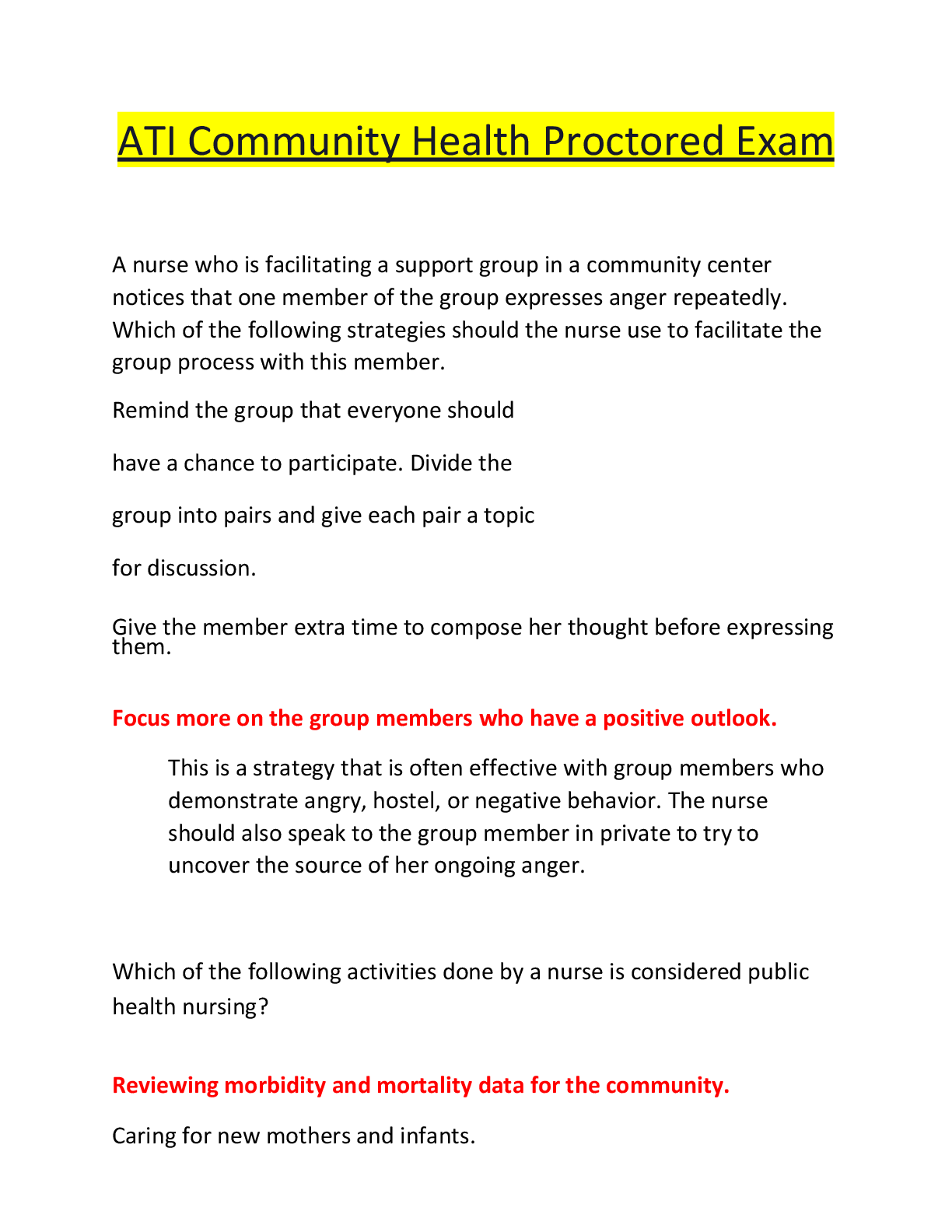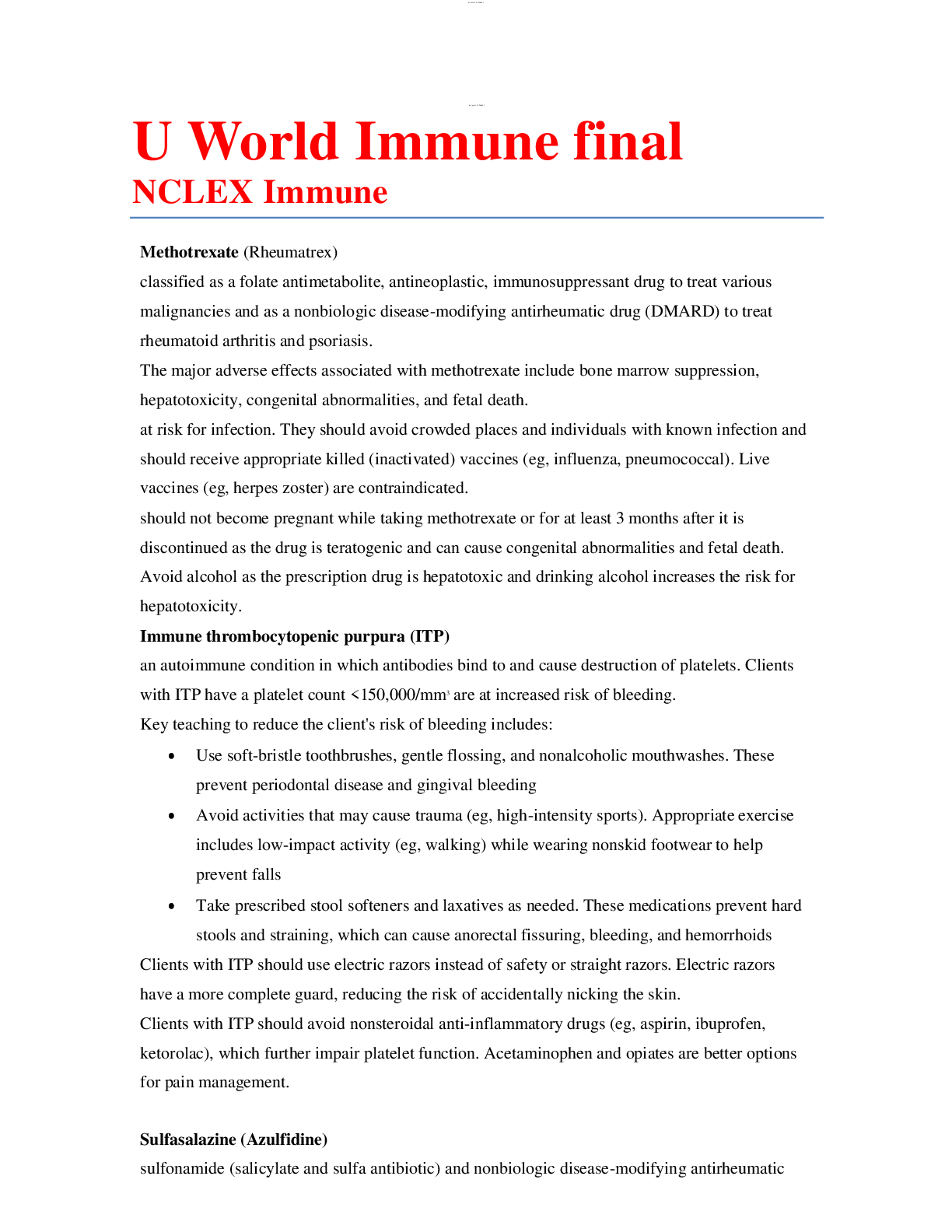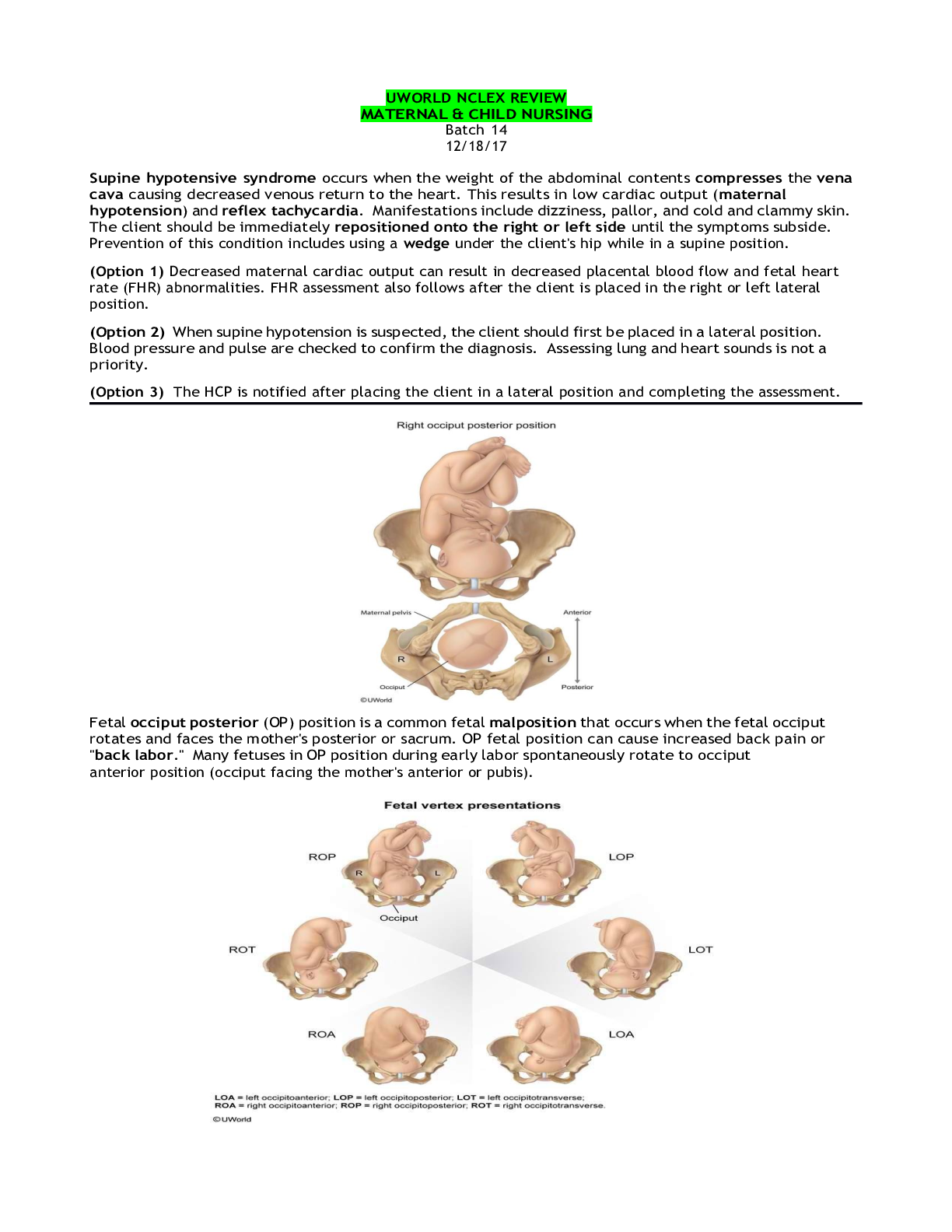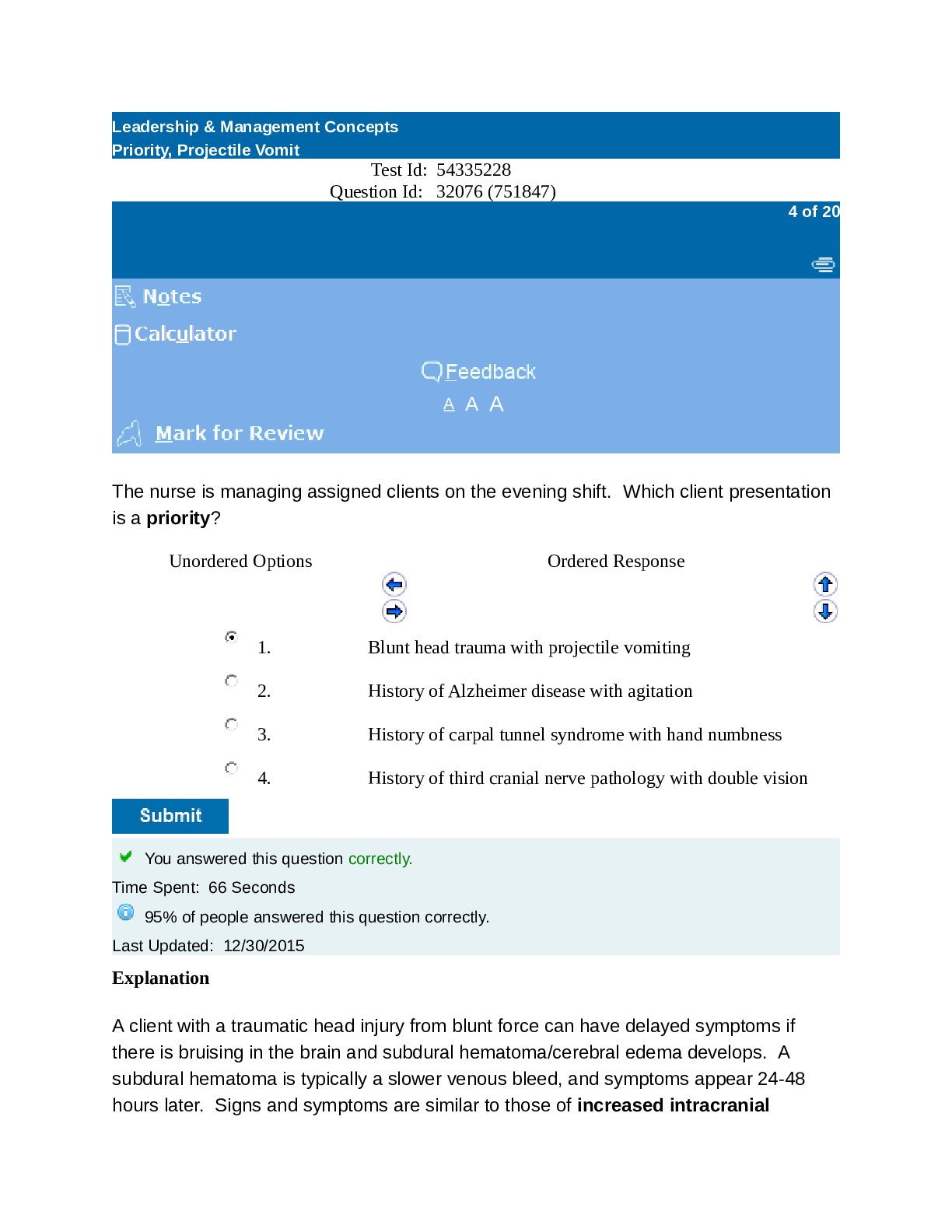2021 UWORLD* Review Study Guide 63 + Pages Comprehensive Material for NCLEX
Document Content and Description Below
UWORLD REVIEW
TB and all airborne transmission based precautions (chickenpox, measles)
Use a surgical mask not an N95 for clients.
This helps protect Health care workers and other clients
...
from respiratory secretions,
and contain respiratory secretions
The HCWs who transport the clients from a negative pressure room to another
location need to wear an N95 mask to protect themselves from infection.
Cirrhosis of the liver. These blood tests would be elevated in the lab results:
Ammonia, bilirubin, prothrombin time
Elevated bilirubin (jaundice) exists due to the decreased inability of the liver to
conjugate and excrete bilirubin
Most coagulation factors are produced in the liver. A cirrhotic liver cannot produce
the factors essential for blood clotting. As a result, the PT, aPTT, and INR levels are
elevated.
Total knee replacement
A recent/current infection is a contraindication to total replacement surgery as a
wound infection is more likely to occur in a client with a preexisting infection.
Burning on urination should be investigated as it could indicate a UTI
Severe knee pain is expected.
Stop taking NSAIDS including selective COX2 inhibitors (celecoxib) 7 days prior to
surgery to decrease the risk of intra and post op bleeding.
Transfusion reaction
Chills, fever, low back pain, flushing, itching)
Stop transfusion immediately, maintain IV line with NS, monitor VS, notify HCP and
blood bank, recheck tags numbers and client’s blood type, and return bag to blood
bank for further testing. Collect blood and urine sample to evaluate hemolysis, and
complete necessary facility paperwork to document the reaction.
Chronic kidney disease with a large plural effusion. Findings :
Decreased fremitus
Diminished lung sounds
A pleural effusion is an abnormal collection of fluid (>1520ml) in the pleural space
between the parietal and visceral pleurae that prevents the lung from expanding fully.
This results in decreased lung volume, Atelectasis, and ineffective gas exchange.
Other s/s: dyspnea on exertion, nonproductive cough, diminished breath sounds,
dullness to percussion, and decreased tactile fremitus. If the effusion is large, the
trachea is deviated to the opposite side.
Sounds travel faster in solids (consolidation) than in an aerated lung, resulting in
increased fremitus in pneumonia. fluid or air outside the lung interrupts the
transmission of sound, resulting in decreased fremitus in pleural effusion and
Pneumothorax. Cancer
Unintentional weight loss of greater than 10 percent of usual weight (in nonobese)
clients require evaluation and could indicate underlying cancer. N, anorexia, and
dysgeusia (altered taste sensation) are also clinical features of cancer and contribute
to weight loss.
CAUTION acronym of cancer
Change in bowel or bladder habits
A sore throat that does not heal
Unusual bleeding or discharge from body orifice
Thickening or lump in the breast or elsewhere
Indigestion or difficulty in swallowing
Obvious change in wart or mole
Nagging cough or hoarseness
Orange peel appearance of breast tissue, or retracted nipple
Restrained client
Position sideways or semi fowlers, because supine position can cause risk of
aspiration
Don’t tie the knot a square knot. Do a quick release knot.
Tie to bed frame not bed rail
Provide care to meet basic needs every 2 hours
Gout
To prevent future exacerbations
1) Achieve and maintain a healthy weight
2) Drink plenty of fluids
3) Limit alcohol consumption and carbonated beverages containing high fructose corn
syrup.
You don’t need to eliminate all foods with protein. Just red meats and seafood
intake
Hip fractures
external rotation, abduction, muscle spasm, and shortening of the affected extremity.
Raynaud’s phenomenon
An episodic vasospastic disorder of the small cutaneous arteries, mainly of the fingers
and toes.
Occurs most often in young women age 1540.
Vasospasm induced color changes of the fingers, toes, ears, and nose.
Decreased perfusion initially causes pallor (white) followed by cyanotic (blue purple)
and last color change is red.
Coldness numbness, followed by throbbing, aching, tingling, swelling (hyperemic
phase).
Exposure to cold, emotional stress, and caffeine, and tobacco use may bring on
symptoms.
Don’t use substances with vasoconstrictive properties Perform stress management
Emphysema
Barrel chest, decreased activity tolerance, diminished breath sounds, distant heart
sounds
Wheezing
SOB that worsens over time
tachypnea, prolonged expiratory phase
Hyperresonance on percussion, pursedlip breathing, use of accessory muscles and
use of tripod position
Hyperosmolar hyperglycemic state complications:
Blood glucose levels are very high (>600)
History of type 2 diabetes. Older age
Neurological manifestations (blurry vision, lethargy, obtundation (decreased LOC),
progression to coma)
Gradual onset of hyperglycemic symptoms (as some insulin is produced)
Hyperventilation and abdominal pain less common
Bicarb greater than 18 mEq/L
Normal anion gap
Serum osmolality >320 mOsm/kg
Negative or small serum ketones
Diabetes insipidus
Insufficient production or suppression of ADH
Polydipsia (increased thirst); polyuria (increased urine output) and can lead to
dehydration resulting in weight loss, hypernatremia, and high serum osmolality (>295
mmol/kg).
Dilute and copious urine (220 L/day) with a low specific gravity (<1.005)
Dilantin (Phenytoin)
Anticonvulsant used to treat generalized tonicclonic seizures.
Therapeutic range: 1020 mcg/ml, and it takes 312 months for steady state to be
reached.
Early toxicity signs: horizontal nystagmus and gait unsteadiness. Slurred speech,
lethargy, confusion, and even coma. Bradyarrhythmias and hypotension are usually
seen with IV Phenytoin
Gingival hyperplasia is common expected side effect of Phenytoin and does not
indicate drug toxicity. Occurs more in those less than 23 y/o who are prescribed >500
mf/day. Good oral hygiene can limit symptoms.
Other s/s: ataxia, decreased alertness
Metronidazole
Metallic taste in the mouth is common It’s an antibiotic
Trisomy 18
A genetic disorder with a short life expectancy (a few weeks after birth) . It’s a
chromosome anomaly characterized by severe cardiac defects and multiple
musculoskeletal deformities.
End of life issues should be discussed early after the diagnosis is confirmed. Trisomy
13 (patau syndrome) also results in death
No treatment at this time available
Warfarin
Anticoagulant. Range: 2.33.5.
Warfarin should only be administered after INR has been checked. Can be given if it
is less than 3.5 and should be held and HCP contacted if greater than 3.5.
Antidote: Vitamin K
Neutrophils
Normal: >1500/mm3
Neutropenic precautions: private room, strict Handwashing, avoid exposure to people
who are sick, avoid ALL fresh fruits, veggies, and flowers; ensure all equipment used
with the client has been disinfected.
Infections in immunosuppressed clients are life threatening
Avoid IM injections and minimize venipunctures when platelet count is below 50,000
as these can cause prolonged bleeding
Blood lead levels
Common source is lead based paint found in houses built before 1978.
Screenings are recommended at ages 1, 2, and up to 6, if not previously tested.
Lead poisoning particularly affects the neurological system, due to immature
development of the brain and nervous system. This is more concerning than the other
effects.
Can cause neuro impairment, developmental delays, reading difficulties, visualmotor
issues; can lead to permanent cognitive impairment, seizures, blindness, or even
death.
GI bleeding is for iron toxicity not lead poisoning.
Lead poisoning is the most threatening to the kidneys and neuro system
(developmental delays, cognitive impairment, seizures).
Liver injury typically does not occur. Severe liver damage is closely associated with
acetaminophen overdose or Reye syndrome.
Asystole
Total absence of ventricular electrical activity (pulseless, apneic, unresponsive)
Treatment: CPR, ACLS, epinephrine and/or vasopressin, advanced airway use, and
any reversible treatment.
Vasopressin is a vasopressor, that increases vasoconstriction and MAP
[Show More]
Last updated: 3 years ago
Preview 1 out of 63 pages
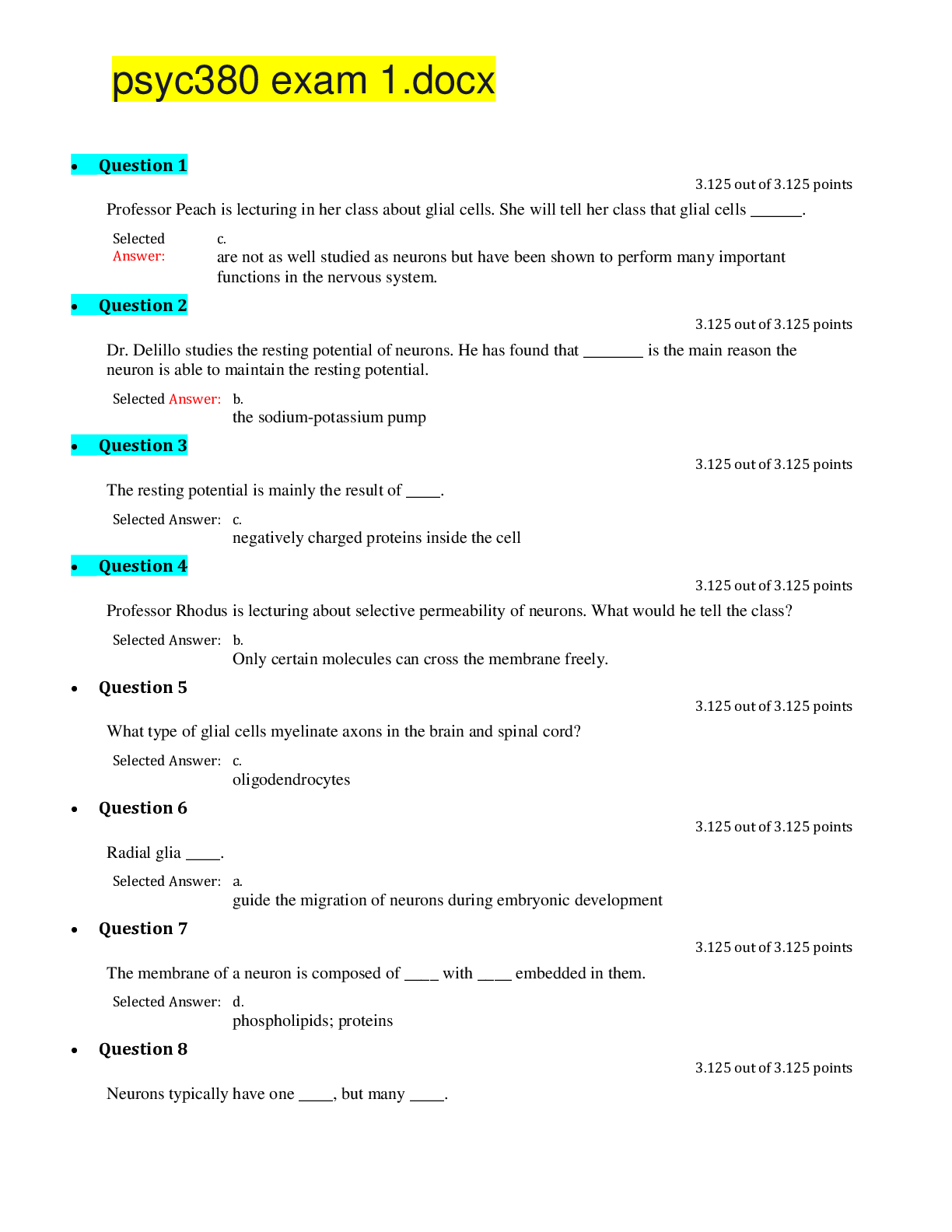
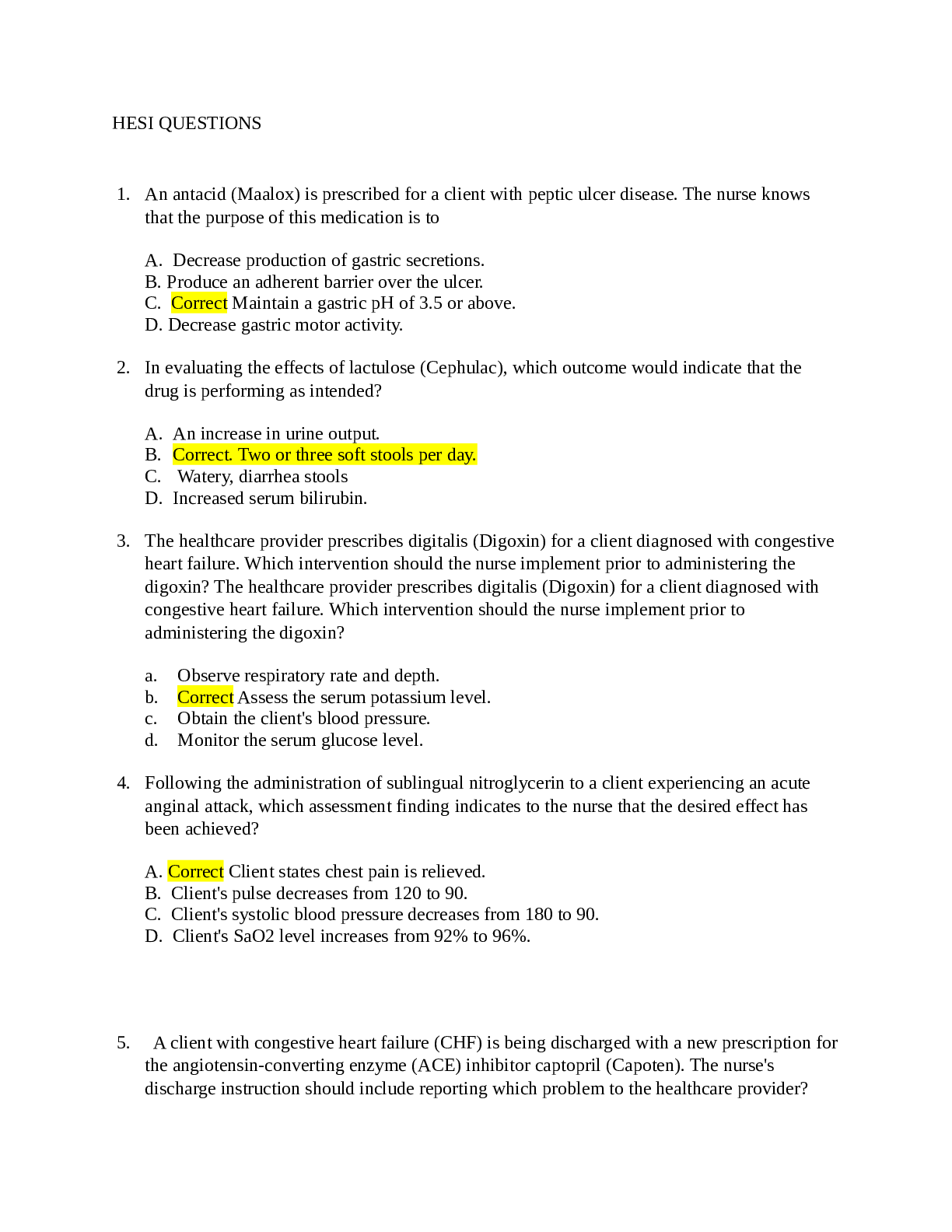



.png)


.png)


